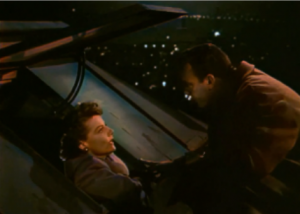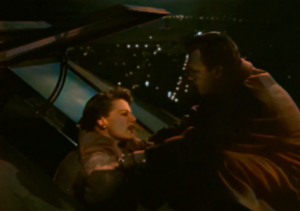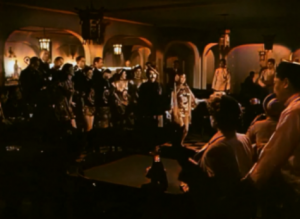2 Woman on the Run (1950)
Woman on the Run (1950): Gender in Film Noir
By Marcus Perry
Film noir is a genre and style of filmmaking that has always stood out to me. Its distinct look and charm creates a unique atmosphere for the viewer, and its deliberate use of low-key lighting and harsh camera angles sets it apart from typical Hollywood films. Although the visual aspects of film noir are some of the genre’s most defining elements, part of what further sets it apart from typical Hollywood films is its darker, broodier themes, and crime-ridden plotlines full of corruption and violence. A lot of what film noir displayed on the screen was new for its time—growing in popularity just shortly after World War 2—society was changing, and certain ideas about gender roles and traditional family values were beginning to evolve.
In a lot of ways, film noir was a direct response to this change in culture. It defended certain patriarchal concepts and ideas—such as women belonging within the home—and often portrayed strong, working women as a threat to “traditional, family values”. As stated by John Belton in the text American Cinema/American Culture, “In leaving the private sphere of home and family to enter the public sphere of work, women […] it was assumed, had abandoned—or at least neglected—the domestic needs of their sweethearts, husbands, and children” (Belton). As if that wasn’t enough, the films also typically depicted these women as being a direct threat to the often victimized male protagonist. Perhaps using their “sexual allure” or by “falsely leading a man on” many of these ‘femme fatales’ of film noir served no further purpose than to torment or toy with the leading men in film. However, one film of the genre sets itself apart by going against many of these concepts, proving itself to be pro-feminist by some standards of today, while also—rather contradictoraly—pro-patriachry in others.
The film Woman on the Run (1950), is a 1950’s crime drama that follows the noir format. The film is notable in the way that it features a female protagonist, as opposed to a rugged, ‘tough-guy’ or an experienced detective. The plot follows Eleanor Johnson, whose husband has run from the police after witnessing a murder. Frank (Eleanor’s husband) is wanted for questioning from the police, but cannot be tracked down. Instead, Eleanor must find him using hints and clues from throughout their marriage to discover where he is hiding. Along the way, Eleanor befriends and employs the help of a news reporter, who—unbeknownst to her—is the man responsible for the murder. Dan (said news reporter) wants to find Frank in order to “silence” him and keep him from talking to police.
Although this film features some common staples found in many noirs that promote certain societal ideas, it also stands out by featuring a female protagonist, and presents a unique opportunity to tell the story of a strong woman who doesn’t need the help of a man to achieve her goals. In some ways, the film is a critique of the way strong, willful women are viewed and treated by society. In other ways, it promotes the harmful idea that women are solely responsible for the overall strength and quality of a household and marriage. These messages, whether intentional or not, are encoded heavily throughout the film’s use of cinematography, plot, themes, and mise-en-scene; most notably during the scene in which Eleanor is dangling off of her apartment’s skylight window.
In this scene, Eleanor is attempting to leave her apartment in search of her husband, against the advice of the police. She is forced to leave through the skylight on the roof of her apartment, as she is under supervision, and manages to get herself up high enough to escape. The editing and framing of the scene up to this point focuses on Eleanor’s wit and capability to outsmart the police and achieve her end goal, however, the introduction of Dan complicates the scene.

Dan briefly introduces himself to Eleanor—then without expressed consent—attempts to lift her up onto the roof. Eleanor insists that Dan let go of her, and that she can do it herself, so he does. In doing so, Eleanor’s footing becomes unstable, and the chair that she had been standing on to reach the window falls as she is left dangling for help. Eleanor now has to accept the help from Dan, or risk facing injury.

This scene stands as a prime example of the complicated nature of the themes and ideologies expressed throughout the entirety of the film, as it seems to communicate two very different ideas. Initially, the film seems to ‘punish’ Eleanor, by putting her in a position where she faces potential physical harm for rejecting the help of a man and paints her as a particularly cold and mean individual—which is implied may have contributed to her marital issues. However, further interpretation of this scene reveals it could be a feminist critique of the way in which strong, independent women are treated by male society.
Eleanor appeared to have been able to escape perfectly on her own, however, the only male presence within the scene automatically assumes she must require assistance, and attempts to help her without expressed consent. When Eleanor rejects this help, Dan essentially forces her into a position where she must not only accept his offer, but faces potential danger if she refuses. This forces Dan into the role of “savior”, while pitting Eleanor as someone in need of help. The framing of this scene enforces these ideas by having Dan look down upon Eleanor, as she struggles and cries out for his help.
By housing both of these conflicting views within the film, it complicates the way in which certain issues, like those of gender, are portrayed and represented. Although the film promotes certain patriarchal ideas, it can also come off as fairly feminist at times. Eleanor Johnson is a willful, independent woman. She refuses the help of the police during the search for her husband, and risks going out to find him, even at the danger of her own life. She is continually shown rejecting the offers of help from men and going about things in her own way. However, Eleanor does not go completely unpunished for her actions. As noted by Erica Waldron, in the article “Women in Film Noir: A Reflection of Postwar Society’s Evolving Gender Roles”, “The manner in which femme fatales are punished in noir is reminiscent of societal backlash against the progressive shift of gender roles” (Waldron), which in doing so, removes any potential feminist intent that a film could have. However, as previously noted, Eleanor is not completely punished for her actions and is successful in saving her husband at the end of the day. Although the narrative seems to label Eleanor as solely responsible for the failure of her marriage, there is no denying that the way in which she takes action into her own hands is an early expression of feminist ideologies—even if obscured by the dominant narrative of the film. The other question of how difference and diversity are displayed is a lot more troubling within this film.
Within the film’s 1 hour and 17-second runtime, there are only three scenes throughout its entirety that depict any characters other than white—all of which take place at the same location, an Asian restaurant, outdated-ly named the “Oriental Gardens”. During these scenes, the only characters who are not white are shown serving and dancing for the patrons of the restaurant—who all just so happen to be white themselves.

Whether intentional or not, this portrayal paints the cultures at hand as nothing more than a gimmick to entertain and serve customers. It encodes the idea that the only role for Asian-Americans within American culture is to offer up bits and pieces of their own culture to serve and sell to white Americans. Not only that, but the only character to play any important role within the plot that is not white, only does so by acting as a murder victim to the main antagonist. What is even worse is that this character is given very limited screen time, and only speaks, briefly, in one scene. The character’s death is not given any weight and is treated solely as a way to move the plot forward. Given the limited and outdated portrayals of the characters within this film that are not white, it is fair to say that this film definitely promotes, or at least encodes, certain outdated ideologies about race within America. Whether intentional or not, it fixates solely on the perspective of white Americans and does not seek to incorporate or explore other perspectives.
This film came to my attention roughly a year ago, when I began exploring various films of the genre. This film captured my interest, particularly because of the way in which it explored topics such as gender and feminism through its lead protagonist. Although some would say that this is a film that deserves to be forgotten to time, I think it stands as an important reminder as to how race and gender used to be displayed within film, and how we have improved in the decades since. Some may consider the film lackluster today, but I think Bosley Crowther put it best when he stated “”Woman on the Run” will not win prizes but it does make crime enjoyable” (Crowther).
References
Belton, John. “Chapter 10 – Film Noir: Somewhere in the Night.” American Cinema/American Culture, Fifth ed., McGraw-Hill Education, New York, NY, 2018, pp. 208–227.
Crowther, Bosley. “The Screen: 3 Films Have Premieres Here; French Import, ‘Orpheus,’ with Jean Marais, New Feature at 55th St. Playhouse.” The New York Times, The New York Times, 30 Nov. 1950, https://www.nytimes.com/1950/11/30/archives/the-screen-3-films-have-premieres -here-french-import-orpheus-with.html.
Waldron, Erica. “University of Oregon Libraries.” Women in Film Noir: A Reflection of Postwar Society’s Evolving Gender Roles, University of Oregon, 2021, https://scholarsbank.uoregon.edu/xmlui/handle/1794/26481.

